Constructive Creativity
Self-Exploitation
Tokenism
Commodification of Self
Commodity
Crypto Currencies
Production of self
Art as a currency
Bartleby
Hunger Artist
Generosity
Sharing Knowledge
Responsibility towards the audience
Charl Landvreugd
Andrius
Kafka
Marx
Oli Mould
Byung-Chul Han
Zizek
Exoitcness
Exoitcness
Mounira Al Solh
Borrowing from your culture
Immanence
Climate Activists Disrupt Multiple Banks across NYC in Coordinated Action.
https://freedomnews.tv/2021/09/17/climate-activists-disrupt-multiple-banks-across-nyc-in-coordinated-action/
Although it is ostensibly about hunger, ‘A Hunger Artist’ is, more widely, about the figure of the artist, and the challenges an artist – any artist – faces when trying to practise their art and gain recognition and admiration for it. The impresario (whom we might liken to the magazine editor, book publisher, theatre manager, etc. in other artistic fields) forces the hunger artist to end his performance after forty days, regardless of whether the man can continue beyond that point or whether he wishes to. By continuing to go without food beyond forty days, he could raise his art to a higher level, but because there isn’t money in it – or an audience that wishes to see it – the artist has his artistic freedom restricted.
well-worn truism, ‘the starving artist’: the writer or artist who suffers and struggles for their art, getting by on little material reward in pursuit of the perfection of their art. The hunger artist is prepared to starve himself to death in order to ‘perfect’ the art he practises.
the relationship between the artist and his audience by delivering the final twist, where it is revealed that the hunger artist’s devotion to his art stemmed not from purely artistic motivations but from personal preference: unable to find any food that he actually enjoyed, he simply chose not to eat.
This raises more questions about the meaning of ‘A Hunger Artist’ and what Kafka might be saying about the relationship between the individual artist and the marketplace. One way to resolve these disparate aspects of the story is to argue that Kafka is exploring the need for artistic autonomy, regardless of either the artist’s motivation or the audience’s preferences. True art comes naturally to the artist, like an inspired genius, and similarly it should be allowed to exist, even if nobody of his time appreciates it or takes an interest. Given Kafka’s determination to write against the trends of his time – he has often been grouped with the modernists, who preferred pursuing artistic experimentation to achieving high sales of their work – we might propose that ‘A Hunger Artist’ acts as a sort of parable for the need of the artist to ‘be’, to practise his art as he wishes, regardless of the vagaries of public taste.
https://interestingliterature.com/2021/09/franz-kafka-a-hunger-artist-summary-analysis/
depriving him of food was not a struggle, because he wasn’t denying himself temptation. Kafka’s protagonist then hardly ‘suffering’ for his art at all. He doesn’t even want the approbation or admiration of his audience. He doesn’t feel he deserves it.
Dear Capital
Ongoing research
Tehching Hsieh
endurance
Anna Longo
Algorithims
it is the algorithms that show you the real meaning of love; by listening to you, looking at you, and constantly caring about you! But do we love them?
The devices will listen to you constantly and will try to come up with the most relevant products to help you go through your struggles with your real online relationships.
Tulip Mania
Speculative Bubble
The term "tulip mania" is now often used metaphorically to refer to any large economic bubble when asset prices deviate from intrinsic values
Futures contracts are derivatives contracts to buy or sell specific quantities of a commodity or financial instrument at a specified price with delivery set at a specified time in the future.
The year 1636 the Dutch created a type of formal futures market where contracts to buy bulbs at the end of the season were bought and sold. Traders met in "colleges" at taverns and buyers were required to pay a 2.5% "wine money" fee, up to a maximum of three guilders per trade. Neither party paid an initial margin, nor a mark-to-market margin, and all contracts were with the individual counter-parties rather than with the Exchange. The Dutch described tulip contract trading as windhandel (literally "wind trade"), because no bulbs were actually changing hands. The entire business was accomplished on the margins of Dutch economic life, not in the Exchange itself
Future Markets
In Europe, formal futures markets appeared in the Dutch Republic during the 17th century. Among the most notable centered on the tulip market, at the height of tulip mania.[9][10] At the peak of tulip mania, in February 1637, some single tulip bulbs sold for more than 10 times the annual income of a skilled artisan.
Scottish journalist Charles Mackay, who wrote that at one point 5 hectares (12 acres) of land were offered for a Semper Augustus bulb.[13] Mackay claimed that many investors were ruined by the fall in prices, and Dutch commerce suffered a severe shock
Ogier de Busbecq, the ambassador of Ferdinand I, Holy Roman Emperor, to the Sultan of Turkey, who sent the first tulip bulbs and seeds to Vienna in 1554 from the Ottoman Empire.[28][29] Tulip bulbs, along with other new plant life like potatoes, peppers, tomatoes and other vegetables, came to Europe in the 16th century.
the singer who didn't want to win
a sailor who mistook the valuable tulip bulb of a merchant for an onion and grabbed it to eat. According to Mackay, the merchant and his family chased the sailor to find him "eating a breakfast whose cost might have regaled a whole ship's crew for a twelvemonth"; the sailor was jailed for eating the bulb
Self-Proclaimed 'Hungry Artist' Eats a $120,000 Banana Displayed in Art Exhibition
David Datuna, a performance artist based in New York
https://time.com/5746098/art-basel-banana-eaten-david-datuna-maurizio-cattelan/
The artwork, named “Comedian,” is by artist Maurizio Cattelan
Goldgar argues that although tulip mania may not have constituted an economic or speculative bubble, it was nonetheless traumatic to the Dutch for other reasons: "Even though the financial crisis affected very few, the shock of tulipmania was considerable. A whole network of values was thrown into doubt."[71] In the 17th century, it was unimaginable to most people that something as common as a flower could be worth so much more money than most people earned in a year
Stanley Brouwn
Another dominant trait of Brouwn's conceptualism was his absence. Brouwn refrained from attending exhibitions of his works and no bibliographical information was supplied to his audiences when viewing such exhibitions.[10] In exhibition catalogues, the following phrase was often seen:
“At the request of the artist, no bibliographical information is provided here”.[11]
Speculative Bubble
Speculative Bubble
Speculative Bubble
Protest
#OccupyWallStreet #RiseAndFall #BusinessInsider
Why Occupy Wall Street Failed 10 Years Ago | Rise And Fall
Occupy Wall Street
raising awareness
circus
carnival
party
Dynamic village
Ben and Jerry food donation!
first was June protests against budget cut for education
Sep 17, 2011 symbolic date and location
wall street where the New York stock exchange is located: a symbolic location
the Bull
17th sep is when US constitution is signed
fight against inequality
1 vs 99
at the same time: anti austerity protests n Greece, Spain, Portugal, UK
and Arab Spring, Tunisia, Libya, Egypt, Yemen, Syria
Occupied Journal
Public Forums: democratic theater
mostly college educated young adults, and not 99 percent
then crashes with police. that made headlines
it got bigger
in Oct 1st around 700 got arrested
added more fuel
went to other cities, Los Angeles, DC and Boston
Nov 15 the owner of the park asked the police to empty it
drug users, homeless, sexual assault, they said had happened
200 got arrested
what did they achieve in terms of policy change? very little
the gap is even higher today
It failed because of lack of strategy:
it was successful in bringing this to public attention, bringing the issue of inequality
into mainstream politics
the inequality of income, wealth, and political power
but you can't have a movement unless you combine activists who are getting attention with activists who behind the scenes are working to mobilize and organize people in a very specific political direction.
demonstrations are a way to get attention, but they are just a start
you also need a leadership to focus on political strategies
from the comments:
the protestors were very clear about what they were against, but there was no message about what they were for.
Nobody knew what they were advocating and without even a rough outline of policies, ordinary people just saw the protestors as a bunch of spoilt and entitled urban kids from well off families disrespecting the authorities that made their country safe.
Removing corporate lobbying from politics, higher "effective" corporate tax rate, environmental protectionism and god knows how many others that would reduce the rate at which wealth inequality and pollution
that was exactly the problem too many "wants" they couldn't stick to one demand and make it happen that's the issue
"I do not protest with the expectation I will change the government, I protest so the government does not change me"
there is always conflicts with the police
there is sit downs
there is tear gas
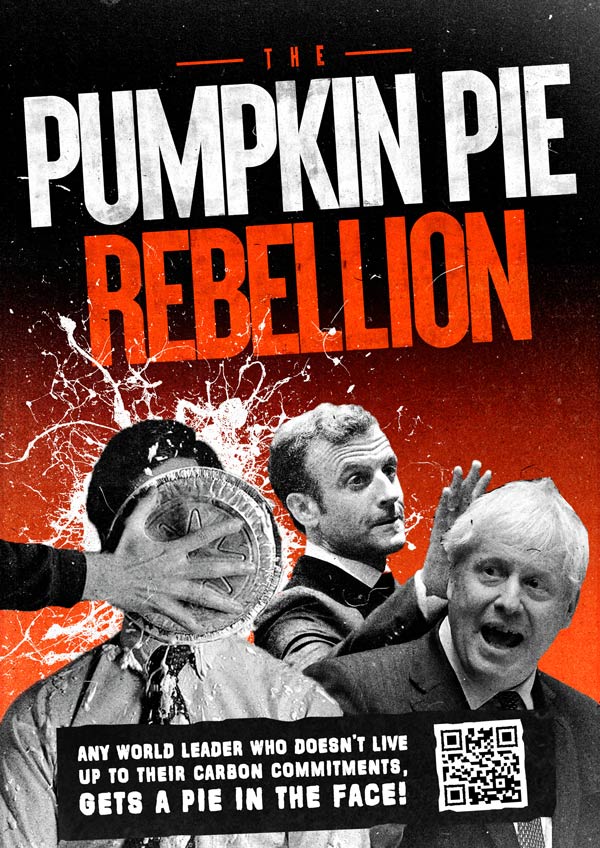
ONE MORNING IN the summer of 2007, five dozen SUV owners in an affluent part of Stockholm awoke to find their cars “reclining on the asphalt.” On their windshields, they found a leaflet. “We have deflated one or more of the tyres on your SUV,” it read. “Don’t take it personally. It’s your SUV we dislike.” The leaflets continued by pointing out how much gasoline the SUVs burned, this burning was directly connected to the rapid warming of the planet, and the drivers would be fine — they might be mildly inconvenienced, but clearly they had money and lived in a city with good public transit. At roughly the same time, the small band of SUV saboteurs published a statement taking credit for the action, exhorting others to copy their work, and making available a “simple manual” for how to release the air from a tire
. It is time, he concludes, for “another stage beyond absolute non-violence.”
Much of the rest of his book amounts to an extended and fervent argument against pacifism, which, Malm writes, is dominant within the mainstream climate activist community.
A true moral pacifist, he writes, would see the example of Mohammed Rafiq — a worshipper who wrestled a gunman to the ground at a mosque in Norway in 2019, thus preventing a likely massacre — and conclude that Rafiq “would have acted more virtuously had he remained seated on the floor when the murderer stormed in
Malm’s ultimate prescription for the climate movement, which is strategic property destruction, not bodily violence.)
XR co-founder Roger Hallam (violence is “disastrous when it comes to creating progressive change”) and renowned activist Bill McKibben (violence might allow “adventurers” to spoil the movement
In the Global South, in other words, the tactics Malm highlights have long been a feature of resistance. Their relative absence in the Global North is, he speculates, partially attributable to “the far right’s virtual monopolisation of political violence.”
Malm indicts the mainstream climate movement — and especially, for being far too deferential to the private property of the rich, as well as to the police
highlighting the climate crisis.
Remember when Extinction Rebellion came on the scene with a furious putsch — blocking roads, getting arrested, and instilling in millions the urgency of the climate fight?
Sure the road blocking pissed people off, but they understood the urgency, and it spawned a worldwide network of climate activists. But after a while that reasoning started wearing thin. The shut-everything-down tactics made a few too many enemies, and XR started switching it up.
Banner drops, blocking corporations, disrupting lawmakers, and a lot of fake blood started taking over. They started targeting the people responsible.
Extinction Rebellion protesters spray fake blood on to Treasury
strategic property destruction.
Mandela’s partisans “considered oil supply an Achilles’ heel of apartheid” and so bombed Sasol plants, actions that “shattered the myth of white invulnerability,”
The European activist group Ende Gelände (translated from German as, roughly, “here and no further”) gets far more space in his book. For years, Ende Gelände has sent thousands of its members to disrupt operations in coal mines and fracking sites
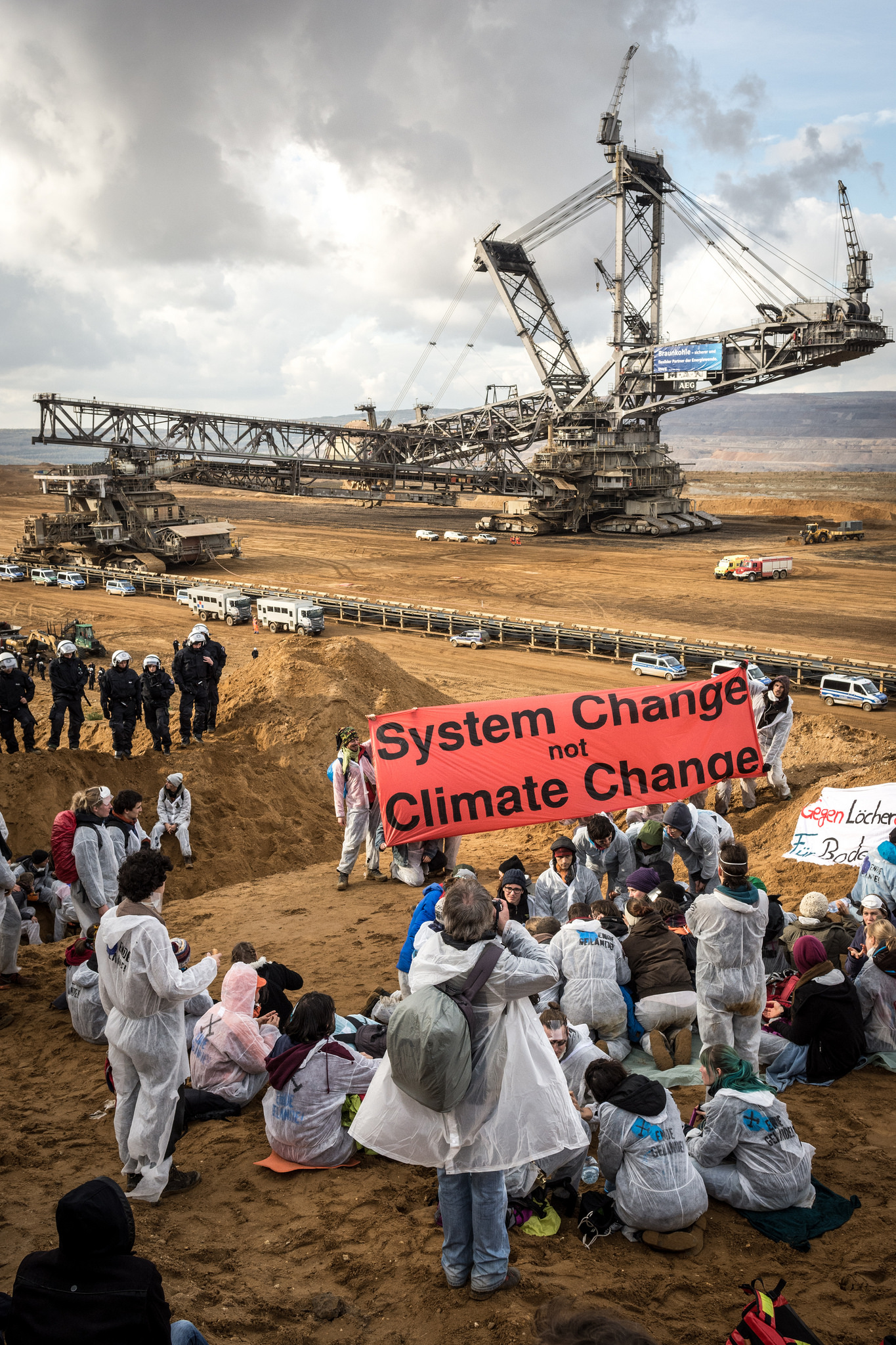




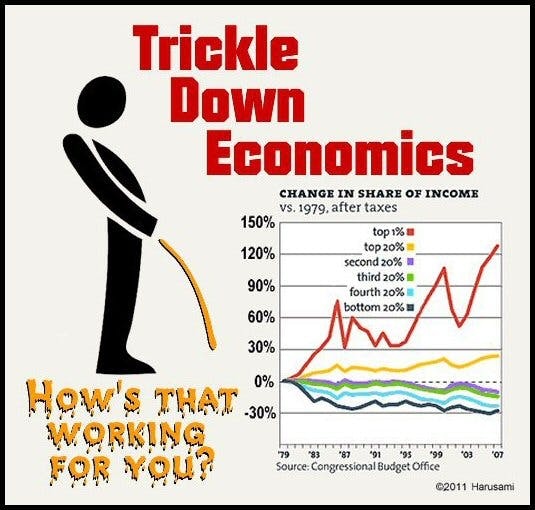


Munk debates
Podcast Episode #20 - Climate Change and Capitalism
Greta: "People are suffering, people are dying, entire ecosystems are collapsing. we are at the beginning of a mass extinction, and all you can talk about is money."
George Monbiot, climate activist and journalist
Andrew McAfee, MIT scientist
G: ending climate change come with end of capitalism as we know it
3 characteristics of all sorts of capitalism:
1. it generates and relies upon perpetual growth to generate profit and accumulate wealth
if growth stops capitalism dim to fail
constant growth cancels all our effort
2. belief that lies in the heart of capitalism, our right to our own natural wealth equates to the amount if money we've got in the bank or that we can borrow
so if you have certain amount of money you can buy as much as land that you want
atmospheric space
planes
you can take away as much as natural wealth from other people as you like
[light growth] turning money into natural wealth
3. everyone can pursue private luxury
but only some people can do that
the fact that only some people have that luxury life is because other people don't
if everybody lived like the rich lived we would have destroyed the whole biosphere
Andrew
I disagree that fighting global warming is incompatible with capitalism
but capitalism can fight with that, in 1970: clean air act against pollution. compare to half a century ago the air is way cleaner in rich capitalistic world
[thirst for profit] all of your profits are eroded when your cost go up >> so it is brilliant that we made pollution expensive and to watch engine of capitalism start to work to minimize that expense and costs
capitalism can fight the climate change, but I don't say that it is working perfectly
G: big industries have moved to china and they are suffering horrendously of air pollution >> kills more people than AIDS, Malaria, tuberculosis
even in Germany again and agian Merkel puts the interest of the car and lignite industry above the interest of the living world and future generation >> inherent characteristic of the system >> power of money and lobbyist defeat our long term interest
efforts are failing
fighting against accumulation in inequality and private luxury
A: it is not true that we moved all the industries to China, fact-check it
US and UK are on a downtrend, but not as quick
what do you think of macro policies?
G: they keep failing, and the reason for that is the lobbying power of money, direct relationship between economic and political power
governments are in the pockets of powerful commercial lobbies and putting those interests above the interests of humanity and the rest of life on that
A; put a price an carbon, we are not doing a right policy
most of industries are against having their costs increased, this necessitates demand from the public to do the right thing, to put in place the playbook that we know works (XR!!!!)
we cannot ask only business to take one for the team! that they have to earn less >> two other forces >> aware public, responsive government
this has been lacking in fight against global warming
what is the alternative? that allows for human flourishing, that has to be part of the sustainable future
G: increasing GDP or allowing some people to accumulate a vast and disproportionate amount of it is not different from environmentalism where the well-being of all the living things should be sustained and enhanced
alternative: PRIVATE SUFFICIENCY AND PUBLIC LUXURY
WE COULD ALL HAVE MAGNIFICENT PUBLIC SWimming pools, and public tennis courts and public playgrounds and public museums and transport system without overloading the living planet
one of the four pillars of economic life: COMMONS
a particular resource, a community which controls that resource and the rules and negotiations that community creates
there are lots of examples, energy cooperatives, community broadband, or the system of allotments hat we have here in the \UK, everyone has an equal piece of land where you can grow your own vegetables and fruit
A TOTAL ALTERNATIVE TO BOTH CAPITALISM AND COMMUNISM
it exists within a sphere of its own, it protects resources, the resource has to be passed on intact, and the resource should be shared equally
A: who gets what? who decides? energy and food? we have systems that provide for the welfare of people.
G: like this we will end the life on the planet, food production and species
UN report: any chance of coming in at no more than 1.5 degrees of global heating, we need to reduce emissions worldwide by 7.6% per year
we are no where near that goal, and because of the dominant economical system of capitalism, everything we do turns back against
A: our total emissions are trending down in the US, but not quickly enough
our energy system is bad, not our economy system
let's say bye to coal and fossil fuels
let's make thew pollution expensive and innovation cheap
put price on carbon, carbon tax
subsidize energy innovation in different kinds and make use of Nuclear energy that can defeat global warming
let's allow commons and facilitate it in some places and see what happens!
G: capitalism is shutting down the commons, seizing their resources, and forcing them into the capitalistic system through colonialism (grabbing land, resources of other nations), and now through similar means be it trade deals, structural adjustment, be it debt.
capitalism is waging war on commons and with the great expense of human liberty and shut down many of the economic and social options that people once had
- COVID-19 in this topic
G: wildlife trade is one of the causes of this diseases arising from other animals >> link with capitalism
universal social income, massive state intervention, forcing private companies to affectively nationalise their operations all of them, which originally are socialists, suddenly became possible >> we realised we could do them after all
if we can do that massive economic change in such as short time because of pandemic, we can also do that for climate breakdown
A: putting people in another form of economic life of mandating that they turn their backs on increase property in order to save the planet >> wow!
if we have trouble to make people to sing up price for carbon, imagine having them sign up for a centrally planned permanent ever deepening recession
G: I think you are confusing prosperity with GROWTH
prosperity: is human flourishing, making sure everybody has their meets met and can lead a happy fulfilling life that's not the same as: Growth of having more and more stuff
GDP is dangerous that forces us to catastrophe
A: let's look at the richest countries, air pollution, water pollution, land, the health of species
in all those areas, most of these things are heading in good directions while people are enjoying a high level of prosperity
capitalistic countries can take care of the planet better!
G: we have not solved it in the last 35 years
we are getting closer to tipping points
if capitalism was good we could have already done something
Occupy Wall Street
Iran
How to blow up a pipeline
The Necessity of Armed Struggle and Refutation of the Theory of "Survival"
سرودهٔ شب نورد
پس از مرگ امیرپرویز پویان، اصلان اصلانیان سرودهٔ «برادر بیقراره» را در ستایش و سوگ او خلق کرد .
قسمتی از این سروده:
برادر بیقراره
برادر شعله واره
برادر دشت سینهش لاله زاره
شب و دریای خوفانگیز و توفان
من و اندیشههای پاک پویان
همچنین در بحبوحه سال ۵۷ قطعهای به خوانندگی محمد رضا شجریان و نوازندگی محمدرضا لطفی با نام شبنورد در بین مردم دست به دست میشد که شعر آن همان سرودهٔ اصلانیان بود.
ابیات
شب است و چهره ي ميهن سياهه نشستن در سياهي ها گناهه تفنگم را بده تا ره بجويم که هرکه عاشقه پايش به راهه برادر بيقراره، برادر شعله واره برادر دشت سينه اش لاله زاره شب و درياي خوف انگيز و طوفان من و انديشه هاي پاک پويان برايم خلعت و خنجر بياور که خون مي بارد از دلهاي سوزان برادر نوجوونه، برادر غرق خونه برادر کاکلش آتشفشونه تو که با عاشقان درد آشنايي تو که همرزم و هم زنجير مايي ببين خون عزيزان را به ديوار بزن شيپور صبح روشنايي برادر بي قرار برادر نوجوونه برادر شعله واره برادر غرق خونه برادر کاکلش آتشفشونه شب است و چهره ي ميهن سياهه نشستن در سياهي ها گناهه تفنگم را بده تا ره بجويم که هرکه عاشقه پايش به راهه برادر بيقراره، برادر شعله واره برادر دشت سينه اش لاله زاره شب و درياي خوف انگيز و طوفان من و انديشه هاي پاک پويان برايم خلعت و خنجر بياور که خون مي بارد از دلهاي سوزان برادر نوجوونه، برادر غرق خونه برادر کاکلش آتشفشونه برادر نوجوونه، برادر غرق خونه برادر کاکلش آتشفشونه تو که با عاشقان درد آشنايي تو که همرزم و هم زنجير مايي ببين خون عزيزان را به ديوار بزن شيپور صبح روشنايي تو که با عاشقان درد آشنايي تو که همرزم و هم زنجير مايي ببين خون عزيزان را به ديوار بزن شيپور صبح روشنايي برادر بي قرار برادر نوجوونه برادر شعله واره برادر غرق خونه برادر کاکلش آتشفشونه برادر، دشمنم خونخواره امشب هواي خانه ظلمت باره امشب چراغي بر سر راهم بگيريد که ديو شهر شب بيداره امشب شب است و مادران شهر غمناک هزاران گل شکفت و خفت بر خاک عزيزم داغدارم دست واکن به پا کن بيرق صبح طربناک شب است و مادران شهر غمناک هزاران گل شکفت و خفت بر خاک هزاران گل شکفت و خفت بر خاک عزيزم داغدارم دست واکن به پا کن بيرق صبح طربناک به عهد شب نظربين ها وفا کن برادرهاي عاشق را صدا کن بزن بر سينه ي شب تيري از نور گل خورشيد را مهمان ما کن به سيل صبح خواهان راه بستند به سيل صبح خواهان راه بستند هزاران سينه و سر را شکستند ولي مردم گرفته دست در دست ز چنگ ديو مردم خوار رستند برادر بيقراره، برادر شعله واره برادر دشت سينه اش لاله زاره شب و درياي خوف انگيز و طوفان من و انديشه هاي پاک پويان برايم خلعت و خنجر بياور که خون مي بارد از دلهاي سوزان برادر نوجوونه، برادر غرق خونه برادر کاکلش آتشفشونه برادر نوجوونه، برادر غرق خونه برادر کاکلش آتشفشونه تو که با عاشقان درد آشنايي تو که همرزم و هم زنجير مايي ببين خون عزيزان را به ديوار بزن شيپور صبح روشنايي تو که با عاشقان درد آشنايي تو که همرزم و هم زنجير مايي ببين خون عزيزان را به ديوار بزن شيپور صبح روشنايي برادر بي قرار برادر نوجوونه برادر شعله واره برادر غرق خونه برادر کاکلش آتشفشونه
تاریخچه
در سال ۱۳۵۰ ام/یرپرویز پویان، از بنیانگذاران سازمان چریکهای فدایی خلق ایران، پس از آنکه در محاصرهٔ نیروهای ساواک قرار گرفت، دست به خودکشی زد. اصلان اصلانیان شاعر و فعال سیاسی چپگرا که با امیرپرویز پویان دوست بود، به یادش شعری با عنوان «شبنورد» سرود که آن را در پنجمین شب از شبهای شعر گوته خواند.[۱]
در بحبوحهٔ انقلاب ۱۳۵۷ ایران، منزل مسکونی محمدرضا لطفی در محلهٔ امیرآباد تهران، در کنار بیمارستان هزار تختخوابی و نزدیک به میدان ۲۴ اسفند (میدان انقلاب)، کانون تظاهرات ضد حکومتی بود. در یکی از شبهای بهمن ۱۳۵۷ محمدرضا لطفی که با لباس آغشته به خون، خسته و پریشان به خانه بازمیگشت، در جستجوی شعری بود تا مناسب حال و هوای آن زمان باشد. او شعر «شبنورد» را یافت و همان شب ساز سهتار را برداشت و در آواز دشتی، موسیقی این تصنیف را ساخت. او خوانندگی این اثر را به محمدرضا شجریان پیشنهاد داد. پس از چند روز موسیقی این تصنیف، شبانه و به صورت مخفیانه در زیرزمین خانهٔ مسکونی محمدرضا لطفی توسط برخی از نوازندگان گروه شیدا ضبط شد و پس از آن در استودیو بل، به خوانندگی محمدرضا شجریان به اتمام رسید.[۲][۳] تا قبل از ۲۲ بهمن، گروههای عارف و شیدا زیر نظر کانون فرهنگی و هنری چاووش به تولید مخفیانه آثار موسیقی حماسی ادامه میدادند.[۴]
محمدرضا لطفی ۲۳ بهمن ۱۳۵۷ یک روز پس از پیروزی انقلاب، با در دست داشتن ۲ سرود «شب نورد» با صدای محمدرضا شجریان و دکلمهٔ مهدی فتحی و «آزادی» با صدای شهرام ناظری، به پخش رادیو میرود. او در اینباره گفتهاست:[۴]
«من وارد اتاق پخش مستقیم شدم و یکی از گویندگان که دانشجوی تئاتر دانشکدهٔ ما بود به من خوشآمد گفت و روی کاغذ برایش نوشتم که دو اثر برای پخش آوردم. ایشان ورود مرا اعلام کردند و بلافاصله شبنورد را روی آنتن پخش کردند. این اولین کار موسیقی ایرانی بود که گروهی ایرانی آنرا به ملت هدیه میکرد
Amir Parviz Pouyan
we get the money from whoever gives it to us!
this guy is a fraud
Extinction Rebellion protests cost Met police £37m so far
This article is more than 2 years old
Figure more than double that spent each year on trying to reduce violent crime in London
https://www.theguardian.com/uk-news/2019/oct/22/extinction-rebellion-protests-cost-met-police-37m-so-far
Money Rebellion
https://extinctionrebellion.uk/act-now/resources/money-rebellion/
https://notalotofpeopleknowthat.wordpress.com/2019/08/03/is-george-soros-funding-extinction-rebellion/#more-40718
Is George Soros Funding Extinction Rebellion?
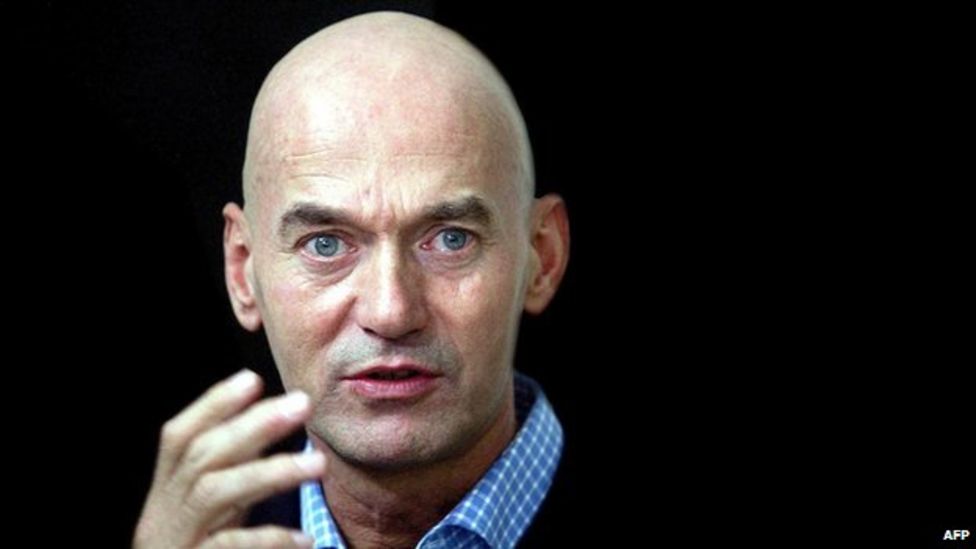

The Dutch authorities have released the man who murdered the flamboyant anti-immigration politician Pim Fortuyn in 2002, now that he has served two-thirds of his jail sentence.
Volkert van der Graaf, an animal rights activist, got 18 years after shooting Fortuyn in the head in Hilversum.
The murder stunned Dutch society, only days before elections. Big gains had been expected for Fortuyn's party.
Van der Graaf said he had seen Fortuyn as a threat to minority rights.
No information has been released about Van der Graaf's whereabouts now. He has to wear an electronic ankle tag and must report weekly to police.
He has expressed remorse for the murder, and prosecutors do not think he will be a repeat offender.
Fortuyn was an openly gay sociology professor who scorned Islam as a "backward culture". He wanted to drastically cut the numbers of immigrants entering the Netherlands - and his message appealed to many voters.
The Pim Fortuyn List (LPF) helped pave the way for the Freedom Party (PVV) of Geert Wilders, whose criticisms of Islam and immigration echo Fortuyn's.

mass resistance
https://massresistance.org/
Rotterdam 04.06.2020 - The monument to Pim Fortuyn on the short Hoogstraat in Rotterdam was defaced with graffiti on Wednesday evening 3 June.
Het bekladde standbeeld van Pim Fortuyn in de Korte Hoogstraat in Rotterdam is donderdagochtend door de gemeente schoongemaakt. Op het beeld van de vermoorde Rotterdamse politicus was de tekst 'racist' gezet.
Rotterdammers herdenken moord op Pim Fortuyn van 19 jaar geleden
https://www.youtube.com/watch?v=rpca9WiqMyo

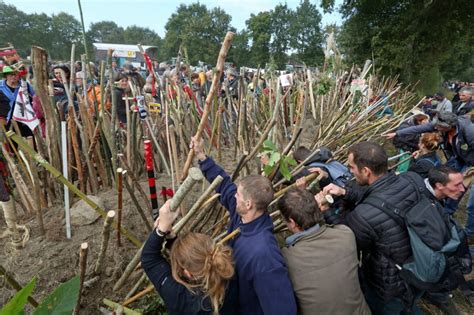



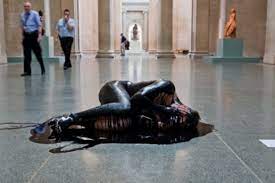


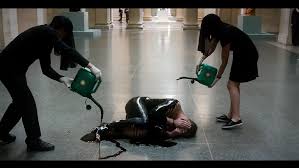


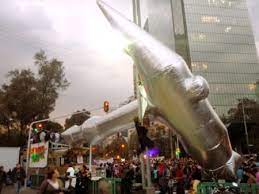


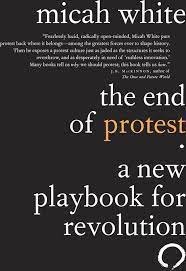
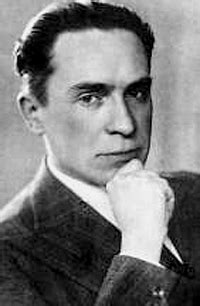
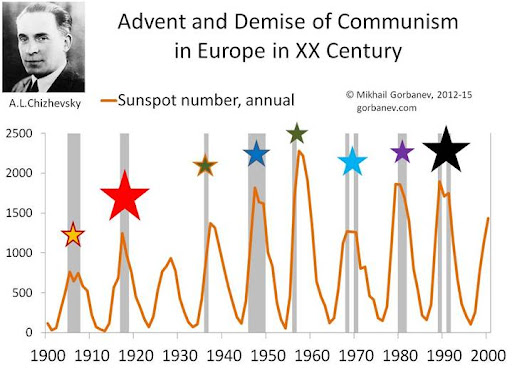
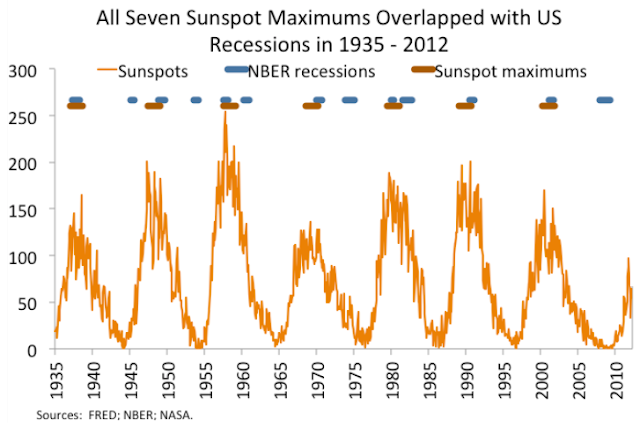
Interaction between the Sun and human excitability
As mentioned in previous commentaries, solar flares have not only been associated with global weather patterns, but also human social activity.
A.L. Tchijevsky
(1897-1964)
During World War I, A. L. Tchijevsky, a Russian professor of Astronomy and Biological Physics, noticed that particularly severe battles followed solar flares during the sunspot peak period of 1916-17. Intrigued by the connection of human behavior to solar physics, Tchijevsky constructed an "Index of Mass Human Excitability". He compiled the histories of 72 countries from 500 BC to 1922 AD to provide a database to articulate his correlations. After rating the most significant events, Tchijevsky found that fully 80% of the most significant human events occurred during the 5 years or so of maximum sunspot activity.
The solar connection to terrestrial events has been studied by scientists ever since then, but most of the focus has been on the sun itself and on the impact of the solar cycle on the climate, weather, agriculture, commodity markets and other non-human phenomenon.
When the data is examined, it appears that when solar-geomagnetic activity is changing most rapidly and is on the ascent or on the descent of a solar cycle, when solar spots are rapidly increasing or diminishing respectively, it has the greatest potential to affect human moods, behavior patterns, creativity and historical trends.
Throughout history, cultures such as Egyptian, Hopi, Ancient Indian, Mayan, Aztec and Chinese, believed that their collective behavior could be influenced by the sun. Seers such as the famous psychic Edgar Cayce, claimed that humans meditating together could influence solar activity and that such meditations can help to establish a more peaceful future and reduce individual and collective stress. More and more groups are continuously forming with this intention. They are stanch believers that prayer, meditations and collective intentions, over time, can help upgrade consciousness and facilitate positive outcomes for the planetary whole. This is especially relevant during times of increased "human excitability," and hence increased creativity and opportunity available from the energy influxes which occur during the increase of solar activity.
Evidence for this is provided from a historical study conducted by Suitbert Ertel ("Bursts of creativity correlate with solar activity"-1997) who examined the association between solar activity and oscillations in human creativity. Using time series analysis he examined the periods of flourishing and years of increased creativity in science and the arts (e.g. painting, poetry and fiction). The results clearly show that during increased solar activity, human creative activity also peaks. Tchijevsky contributes this observation to the fact that the influence on the human nervous system is greatest when the amount of emitted energy by the sun and radiation of the earth are greatest.
We are at the beginning of the next Solar Cycle 24, which will increase over the next four to six years. There are always pessimistic and fear-based projections related to any new energetic cycles that have an interactive influence with the planet. However, the increasing light and coherence on the planet facilitates new choices and the power to change our responses to energy influxes. That’s what the global consciousness shift is about: a chance to elect heart-based choices, then take charge and do things differently and respond with more consciousness, respect, love and compassion. It’s time to end the tendency to create and repeat the same old stress-producing "play-outs" each time there in an energy influx on the planet—such as solar activity and other energetic influences—that could bring benefits and creative opportunities to help humanity spiral upward towards the next dimension of active intelligence and heart-based living.
More and more people are realizing that solar and universal energetic influxes are part of a natural cycle—they are not "out to get us". Their effects depend on how we choose to respond to them. These influxes can be a great add-on to humanity. Yet people have to take responsibility for their own energy and elect to use this creative energy influx to create deeper connections and more caring interactions with each other and Mother Earth. The GCI’s intention is to help provide self-transformational tools and technologies that help people align with their higher potentials for empowerment, in order to facilitate positive global change during the influx of the next solar cycle.
The GCI hypothesizes that:
1. All living things are interconnected and that we communicate with each other via our biological and electromagnetic fields.
2. Not only are humans affected by such energetic fields, but conversely the Earth’s energetic systems are also influenced by collective human emotions and consciousness. Much of the planetary field environment is made up of the collective consciousness of the inhabitants.
3. Large numbers of people intentionally creating heart-coherent states of care, love, compassion and appreciation will generate a coherent standing wave that can help offset the current planetary-wide wave of stress, discord and incoherence.
A major factor in the global consciousness shift is enough people realizing the need to become more self-responsible for their own energy, thoughts, feelings and actions. It is each person’s responsibility to establish balance within oneself and with the Earth. Every action counts, and by "taking charge" and increasing our coherence baseline, this shift and consciousness upgrade will be reflected in the global field environment as well. This in turn will create a mutually beneficial feedback loop between human beings and the Earth’s energetic systems.
Though not fully proven yet, we at the GCI research center feel that using our heart’s intelligence to balance and manage our mental and emotional systems, along with meditations to increase our coherence, will raise our personal frequency pitch and energetically align us with the creative opportunities and benefits that can come with this next cycle of solar activity. More people are becoming aware that they have a choice in how they interact with new energy influxes—be they spiritual, astrological, solar, lunar, environmental or social.
The Global Coherence Initiative is only one of the many emerging groups working to facilitate the planetary shift in these adventuresome and sometimes challenging times. No facilitation is "more important" than another. With a noncompetitive spirit and genuine care, all groups and individuals add a helpful piece to the grid and are energetically connected to each other at the heart level to serve the greater whole. We at the GCI honor and appreciate the love and care these groups and individual light workers from all over the world have put into this cause.
With gratitude and appreciation,
Annette Deyhle, Ph.D. and GCI Research Team
Influence of Geomagnetism and Schumann
Resonances on Human Health and Behavior
July 15, 2009
In this commentary I would like to focus on this question: Is there a connection between solar activity, geomagnetic storms and the Schumann resonances and human health and behavior?
In the last commentary, I discussed the Schumann resonances. Like a tuning fork, the earth has natural sound frequencies and these are called Schumann resonances. There are about 1000 lightning storms at any given moment worldwide, which excite the cavity. These resonances form in the conductive ionosphere which acts as a wave-guide. The limited dimensions of the earth cause this wave-guide to act as a resonant cavity for electromagnetic (EM) waves in what are extremely low frequencies bands (see figure below).
The lowest-frequency mode of the Schumann resonances is approximately 7.83 hertz (Hz), with a daily variation of about ± 0.5 Hz. The other frequencies are 14, 20, 26, 33, 39 and 45 Hz.
At the time physicist W.O. Schumann published the results of his research about these resonances in the journal Technische Physik, a Dr. Ankermüller, a physician, immediately made the connection between the Schumann resonances and the alpha rhythm of brain waves. He found the thought of the earth having the same natural resonance as the brain very exciting and contacted Professor Schumann, who in turn asked a doctoral candidate to look into this phenomenon. This doctoral candidate was Herbert König, who became Schumann’s successor at Munich University. König demonstrated a correlation between Schumann resonances and brain rhythms. He compared human EEG recordings with the natural electromagnetic fields of the environment (1979) and found that the first five Schumann resonances, 0-35 Hz, to be within the same frequency range as the brain waves in a human EEG and the 7.8 Hz signal to be very close to the brain’s alpha rhythm frequency.
The first five Schumann resonances overlap with the brain frequency bands. Note: Brain waves are grouped according to their frequencies and are labeled with Greek letters. Their most common frequencies include alpha, beta, delta and theta.
State
Frequency Range
State of Mind
Delta
0.5Hz - 4Hz
This occurs in a deep dreamless sleep or unconsciousness.
Theta
4Hz - 7Hz
This is associated with drowsiness. It also occurs at first stage of sleep and during deep meditation, when we are awake but open to mental imagery. It has been associated with creativity, intuition daydreaming and fantasizing. Believed to reflect activity from the limbic system and increased activity is observed in anxiety, behavioral activation and inhibition.
Alpha
8Hz - 12Hz
This is the major rhythm seen in a normal, relaxed adult. It is present during most of life. It is considered a common state during alertness but not actively processing information. Alpha has been linked to creativity (creative people show alpha when listening and coming to a solution) and mental work. Alpha activity is also associated with overall mental and body/mind coordination, calmness, alertness and learning.
Beta
12Hz - 30Hz
Beta reflects highly active processing. Occurs during normal waking consciousness and outward attention. Slow beta: 12-17 is normal information processing and mental activity; Fast beta: 17-30 is heightened alertness and fight or flight, or anxiety.
Gamma
30Hz - 100Hz
This is associated with waking states and can occur when we are simultaneously processing information in both brain hemispheres. Whales and dolphins also operate in these frequencies.
Since this first discovery, more scientific research has posited that Schumann resonances are very important electromagnetic standing waves, acting as background frequencies and influencing biological oscillators within the mammalian brain.
As long as the properties of Earth’s electromagnetic cavity remain about the same, these frequencies remain the same. Some of the changes that occur in the Schumann resonances are caused by the solar sunspot cycle as Earth’s ionosphere changes in response to changing solar wind associated with the 11-year cycle of solar activity. As the mean intensity of the Schumann resonances increases or decreases because of day/night differences, changes in solar activity, global weather, etc., our brains and nervous systems respond to the changes.
Resonance may be defined as the frequency at which an object most naturally wants to vibrate. For example: In coherent systems, one object may set another object into motion if it shares the same resonant frequency. If, for example, you strike a tuning fork of 100 cycles per second and bring it near another tuning fork of that same frequency, the second tuning fork will be set in motion. Even though it has not been struck, the second fork will begin to vibrate and radiate a sound merely by being in the same field as the vibrating tuning fork.
Similar to the tuning-fork example, evidence shows it is possible for the brain to detect, tune into and respond to a Schumann resonance signal.
The question arises: How are we able to tune into the Schumann resonances?
The answer is that our brain possesses Zeitgeber, a German word that translates literally to time givers and refers to external agents or events that provide signals – in this case, the Schumann resonances. These external signals help the human biological system to become synchronized with the daily rhythmic cycles of the earth.
Research within the last decade shows that significant alteration in solar and geomagnetic activity caused by such things as geomagnetic storms can precipitate significant changes in the intensity and stability of a Schumann resonance signal. This can take a Schumann resonance signal outside of its normal range and induce alterations in brain and heart synchronization and changes in the brain’s melatonin level.
Some ill effects associated with changes in solar geomagnetic activity:
· Altered blood pressure.
· Reproductive, immune system, cardiac and neurological problems.
· Mental disorders, depression and suicide.
· Increased hospital admissions, accidents and sudden death, as well as countless other stress-related conditions.
A number of human reaction-time experiments have been conducted relative to external events and Schumann resonances. In 1974, for example, König showed that human reaction times were significantly correlated with the intensity of the 8-10 Hz Schumann signal. Ten Hz have been shown to speed up reaction times, while 3-Hz signals from local thunderstorms have been shown to significantly lower reaction times. This phenomenon can be demonstrated by changes in EEG patterns and calcium ion uptake in the brain.
The effects of manmade electromagnetic fields on human health
The electromagnetic fields generated by power supply systems, telecommunications, appliances, computers and other technology produced by humans are extremely powerful and in some cases have been associated with increased incidence of cancer, heart disease, depression and other diseases. Exposure to strong electromagnetic fields in residential areas and in certain occupations has been documented as significantly increasing the incidence or risk of the listed diseases. Certain groups of people such as the elderly, children, women who are pregnant and the weak have been found to be more sensitive or susceptible to adverse effects from these fields than the rest of the population. (As is often the case with research, there are opposing opinions on the existence or extent of such adverse effects.)
Thus we see that the Schumann resonances, geomagnetic and solar activity influence human health and behavior. It is exciting to see that the study of Schumann resonances points towards the interconnectedness of all (us, our planet earth, the sun, and probably many other planetary factors we are not aware of yet).
Much more detailed research has been carried out, but it is beyond the scope of this commentary to go into it.
So, in summary, researchers have found evidence indicating that human health and behavior appear to be affected by changes in Schumann resonances. Also, many scientists believe these resonances may be important in human biological cycles.
Possible future considerations for scientists with respect to the Schumann resonances include learning why some people are adversely affected by changes in them, why most people are not and what can be done to help those who are.
In addition to exploring whether mood and health are affected by Schumann resonances, researchers also have studied whether there is a link between historical events such as wars and social unrest with the solar cycle and resulting changes in ionospheric activity. I will write more on this subject in an upcoming commentary.
Allow me to mention two items not directly related to today’s topic:
· Because increased geomagnetic activity can cause an imbalance in heart-brain synchronization, we want to encourage you to practice coherence regularly to help you maintain that balance.
· You probably have received e-mails about the GCI’s current Interconnectedness Study, which is aimed at helping us gain a more holistic picture of human health and behavior and how these are influenced by various planetary factors. We will keep you informed about the results. A likely second Interconnectedness Study, in case you missed out on this one, should take place in about six months.
Remember what Albert Einstein said: "Everything in life is vibration."
Until next time, best wishes for good vibrations in your life,
Annette Deyhle, Ph.D. and GCI Research Team
Earth’s Atmosphere, Schumann Resonance and
the Ionosphere
May 11, 2009
First and foremost I want to thank all of you for providing so much insightful feedback to my last commentary. Have you heard, our global coherence community now has over 13,000 members?
Two major events have happened since my last update: A 5.8-magnitude earthquake in Italy claimed the lives of nearly 300 people and left 29,000 homeless; and the swine flu outbreak, which had reached 2,500 confirmed cases worldwide as of May 8 and resulted in 44 deaths – 42 in Mexico and two in the U.S. – threatened for a time to become a pandemic, creating a great deal of fear and anxiety.
Many questions have been asked and I will address one of the most frequent: What happened during Obama’s inauguration? In the following, I explain a case study of data from our magnetometer, Maggie, as well as data provided by researcher Roger Nelson from the Global Consciousness Project random number generator (RNG) network. The information from Maggie illustrates the kind of data we are starting to see with the ultrasensitive magnetometer and what it may be telling us. We are on the frontier where new science is created, and we are glad you are on board with us.
For those interested in the scientific background, I will continue to explain some more basics behind GCI and the ionosphere and magnetometer data. Feel free to scroll down to the data related to Obama’s inauguration if you would like to skip this science.
Earth’s Atmosphere, Schumann Resonance and the Ionosphere
As mentioned in the previous commentary, the Earth is surrounded by a blanket of air reaching over 350 miles into space. The atmosphere is essential for life on the planet. It provides the air we breathe, water is recycled and the ozone layer protects us from the harmful effects of ultraviolet light, which can cause skin cancer. The atmosphere has four layers, the troposphere (about 0-10 miles), stratosphere (about 10-30 miles), mesosphere (about 30-50 miles) and thermosphere about 50-375 miles, see figure from NASA below).
Within the thermosphere is a band called the ionosphere that begins about 50 miles out from the Earth’s surface and extends out to about 180 miles. It consists of charged particles. This highly dynamic region is constantly exposed to the full intensity of the sun; harsh ultraviolet radiation is breaking down molecules and atoms. Highly charged ions and free electrons therefore fill the ionospheric layers. A solar storm can pump charged particles into the magnetosphere and ionosphere. The ionosphere consists of three basic layers: D, E, and two F layers; during the night the D layer disappears, the E layer nearly disappears and the F layers combine (see figure from NASA below).
Scientists have found that extreme solar activity drastically compresses the magnetosphere (the protective magnetic bubble carved out by Earth’s magnetic field) and modifies the composition of ions in the near-Earth space. These changes and disruptions in the ionosphere are detected by magnetometers.
Such increased solar activity affects the ionosphere, upper atmosphere, and Earth’s weather. This is why monitoring and forecasting its impact on near-Earth space is becoming increasingly critical to safeguarding daily life on Earth.
You can watch the effect of extreme solar activity on Earth’s magnetosphere by following this link: www.physorg.com/newman/gfx/news/hires/watchingsola.gif.
Schumann Resonances:
Schumann resonances (SR) are the electromagnetic frequencies of the Earth-ionosphere cavity (see figure below) and were first predicted by W.O. Schumann (1952). Electromagnetic impulses, like those from global lightening flashes (the world’s thunderstorm activity) fill this cavity and excite the Schumann resonances. Resonances can be observed at around 7.8, 14, 20, 26, 33, 39 and 45 Hz (see the live data at www.glcoherence.org/monitoring-system/live-data.html).
The observation of Schumann resonances can provide valuable information about solar activity, world thunderstorm activity, properties of the upper dissipative boundary layer, the Earth-ionosphere cavity and climatic changes. It has been found in previous studies that the Schumann resonances can influence human health indicators such as blood pressure, and it is likely that they also affect cardiac and neurological disease, violence and war, some of which was discussed in my last commentary.
Random Number Generators (RNGs) and Maggie – IHM’s Magnetometer: Data and Intentionality
An RNG is an electrical device that randomly produces a sequence of numbers – either 0 or 1 – 200 times a second) which should be a random string of numbers that equal out to 100 0’s and 100 1’s and that results in a flat line when they are all added together. Roger Nelson started the Global Consciousness Project when he was at Princeton University and is a collaborator with the GCI (http://noosphere.princeton.edu/).
During events in which millions of people share emotions globally such as Barack Obama’s Inauguration, many people seem to come into alignment, or coherence.. In this case, the random production of 0’s and 1’s from 65 RNGs at host sites in 41 countries went out of balance: Small, but meaningful differences from expectations can be seen in the data (for example, more 1’s than 0’s were produced or more 0’s than 1’s). This is also true for events in which the power of group focus such as during meditations has been applied intentionally, with the goal of having a positive impact on troubled areas on the planet, whether it is a war zone or an area struck by natural catastrophe. Although RNG data can detect imminent events, it does not tell us what is in store.
Obama’s Inauguration:
RNG data
To help us better understand the global impact of Obama’s inauguration, we will examine the RNG data from the Global Consciousness Program (see figure 1. below) and our "Maggie" data.
Figure 1.
Shows the network variance of the Global Consciousness Project’s random number generator network before, during and after the inauguration of President Obama.
The formal event specification for the inauguration was extended both before and after the swearing-in, attempting to capture the anticipation and the celebration of the estimated 1.5 to 2 million people in Washington D.C., and hundreds of millions watching the ceremonies on TV around the world. The event was set for 6 a.m. on the 20th to 2 a.m. on the 21st, EST.
The result is graphically quite striking, with no trend for the first four hours. Then there is a very steady trend showing smaller than expected network variance for about 12 hours, and finally a change to a period of relatively large variance. For a more detailed explanation, go to the Global Consciousness Project Web site at http://noosphere.princeton.edu/.
Maggie Data
The following two graphs show some preliminary data from Maggie, the magnetic field detector developed by the Global Coherence Initiative research and development team to monitor the resonances occurring in the plasma waves constantly circling the Earth in the ionosphere.
Figure 2.
This is a plot of daily spectrograms of the Schumann resonances for the four days before, day of and three days after President Obama’s inauguration. The intensity levels of the resonances are substantially lower the day of and the days following the inauguration than the days preceding it.
Figure 2 is a frequency-time spectrogram of the horizontal component of the Schumann resonances. Within the spectrograms, the power of the intensity at the right side of Figure 2 of a given frequency is coded in a color scale, with yellow being the most intense. The typically daily variations in the intensity of the resonances can be seen in the figures. The time of the presidential swearing-in at 12 p.m. EST on the 20th is noted by the red arrow. At the left of Figure 2 is a vertical section through the spectrogram showing the typical resonance structure for Jan 16 on the upper row and Jan 20 on the lower row.
The resonances are shown by the red lines that appear as horizontal lines with frequencies of 7.8, 14, 20, 26, 33 and 39 hertz. The daily time periods shown in each daily plot are 10 a.m. to 4 p.m. PST. The grey boxes were added to omit the data that was contaminated on several of the days by a local noise source – a solar charger that was being eliminated.
Figure 3.
This shows the total spectral power in the frequencies between 5 and 40 hertz for the same days shown in Figure 2.
GCI researchers note that an interesting observation of this data is the pronounced change in the activity level of the resonances. As shown in both figures, there is a pronounced drop in intensity on the day of the inauguration that persisted during the three days following it. The GCI research team has been exploring changes in space weather and other indicators of ionospheric activity such as ion density that could explain the changes in resonance intensity. So far, the changes do not appear to correlate with other indicators that are known to affect ionospheric activity. However, it is possible that we are seeing an effect of human consciousness acting on global weather patterns.
Similar observations were made during another event, World Sound Day, on Feb. 14 of this year, but we are still exploring the data. Data comparable to Obama’s inauguration for RNGs and Maggie were obtained. This was a day when people around the planet took five minutes to send a sonic Valentine to the Earth with the heart sound "AH," which was filled with the intention of peace and love.
Obviously, so far we can only speculate about the meaning of the data, and we are excited about continuing this interesting journey of helping to increase global coherence. Might the alignment of many millions of people in most countries of the world cause a quiet period in the magnetometer data? Does the data correspond with uniting the emotions of many, allowing for more global peace and harmony? Because solar storms increase the intensity in the level of resonance, which in turn causes health challenges, violence etc., the data could be a first indicator that we are taking the right steps with our innovative research in monitoring the ionosphere.
So far we have taken an exploratory look at the possibility of global events being the catalyst for the kind of coherence that we think of as a global consciousness. A word of caution, however: Our research team knows that to scientifically prove our theory, the real effect only can be identified by repeatedly monitoring events that have similar impact.
In closing our commentary today, and in appreciation of Earth,
"The mountains, rivers, earth, grasses, trees, and forests are always emanating a subtle, precious light, day and night, always emanating a subtle, precious sound, demonstrating and expounding to all people the unsurpassed ultimate truth." –Yuan-Sou
Best wishes for much coherence, health and harmony to you all,
Annette Deyhle, Ph.D. and a member of the GCI research team
https://docs.google.com/document/d/1XVAYMYMXH8_94t3o8k-TTFJan4UaEZYimNN514vbEck/edit#
http://theperihelioneffect.com/tchijevskys-theory-of-sunspot-activity-and-human-activity/
performance
http://doragarcia.org/
http://www.jeremydeller.org/AfterTheGoldrush/AfterTheGoldrush.php
http://johannabilling.com/category/shows/
https://www.tate.org.uk/art/artists/roman-ondak-7622
https://www.tate.org.uk/art/artists/artur-zmijewski-13100
https://www.mariangoodman.com/artists/62-tino-sehgal/
https://walkerart.org/collections/publications/performativity/be-the-work
https://www.theguardian.com/artanddesign/2021/jul/11/tino-sehgal-blenheim-palace-interview
George Maciunas
anti-capitalist, anti-elitist, pro-community, and pro-play.
On the one hand, its goal was to propose a new kind of art in which anyone could participate, and to create an avant-garde so integrated into life as to become the new, enlightened normal. At the same time, Fluxus preserved and cherished its distanced, critical status, as exemplified in its sly, funny sendup of corporate culture and its socialistic innovations.
And anyone who wants to get a sense of Maciunas himself, and the Fluxus universe in which he lived, will want to watch Mr. Mekas’s swiftly flowing 1992 film, “Zefiro Torna, or Scenes from the Life of George Maciunas.” It plays continuously in the gallery, and it’s exhilarating and heartbreaking
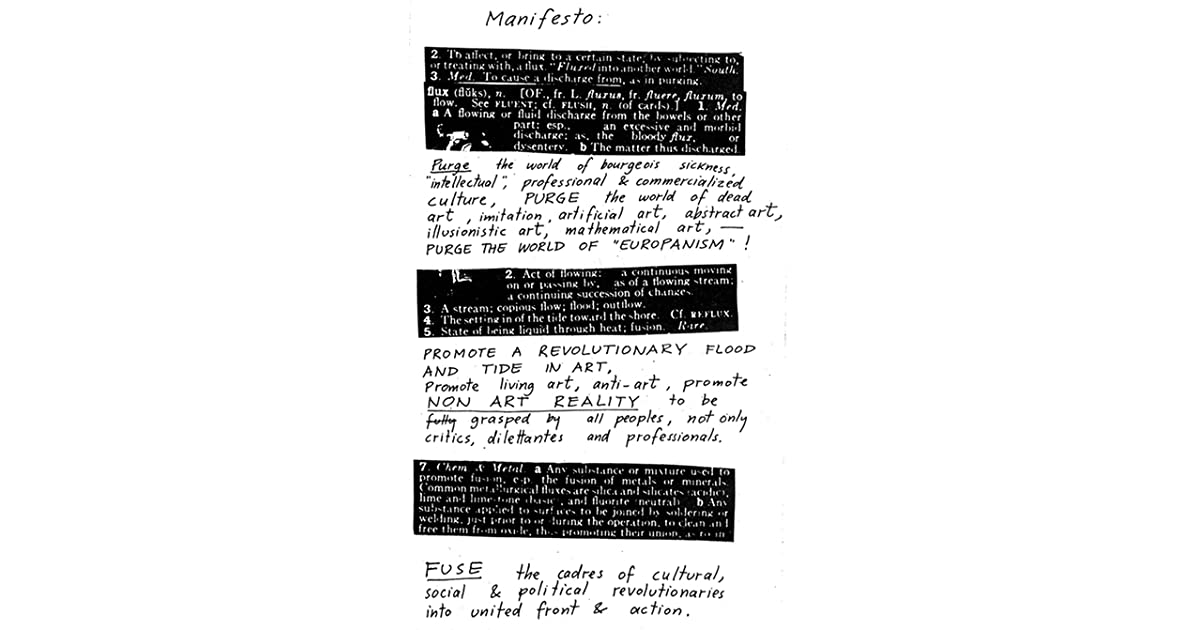

Nam June Paik, Performing La Monte Young’s “Composition 1960 No. 10” to Bob Morris (Zen for Head), (1962)
Presented during the Fluxus International Festival of New Music, this performance was Paik’s interpretation of La Monte Young’s Composition 1960 No.10 dedicated to artist Robert Morris who was quoted saying, “Draw a Straight Line and Follow it”. Paik’s performance consisted of him dipping his head, hands and tie in a bowl of ink and tomato juice and drawing a line by dragging his head along a narrow piece of paper laid out on the floor. Fluxus was concerned with carrying out deceptively simple actions in order to concentrate on the subtlety of a gesture, bringing about a fusion of art with life. In Zen for Head, Paik parodies the notion of meditative art-making by physically enacting a painting gesture using the body as a tool rather than the repository of mental or spiritual processes. The head, the source of creative thinking, becomes the mark maker, actively engaged in the process of material and action.
https://rudygodinez.tumblr.com/post/81844228786/nam-june-paik-performing-la-monte-young-s-composition-19
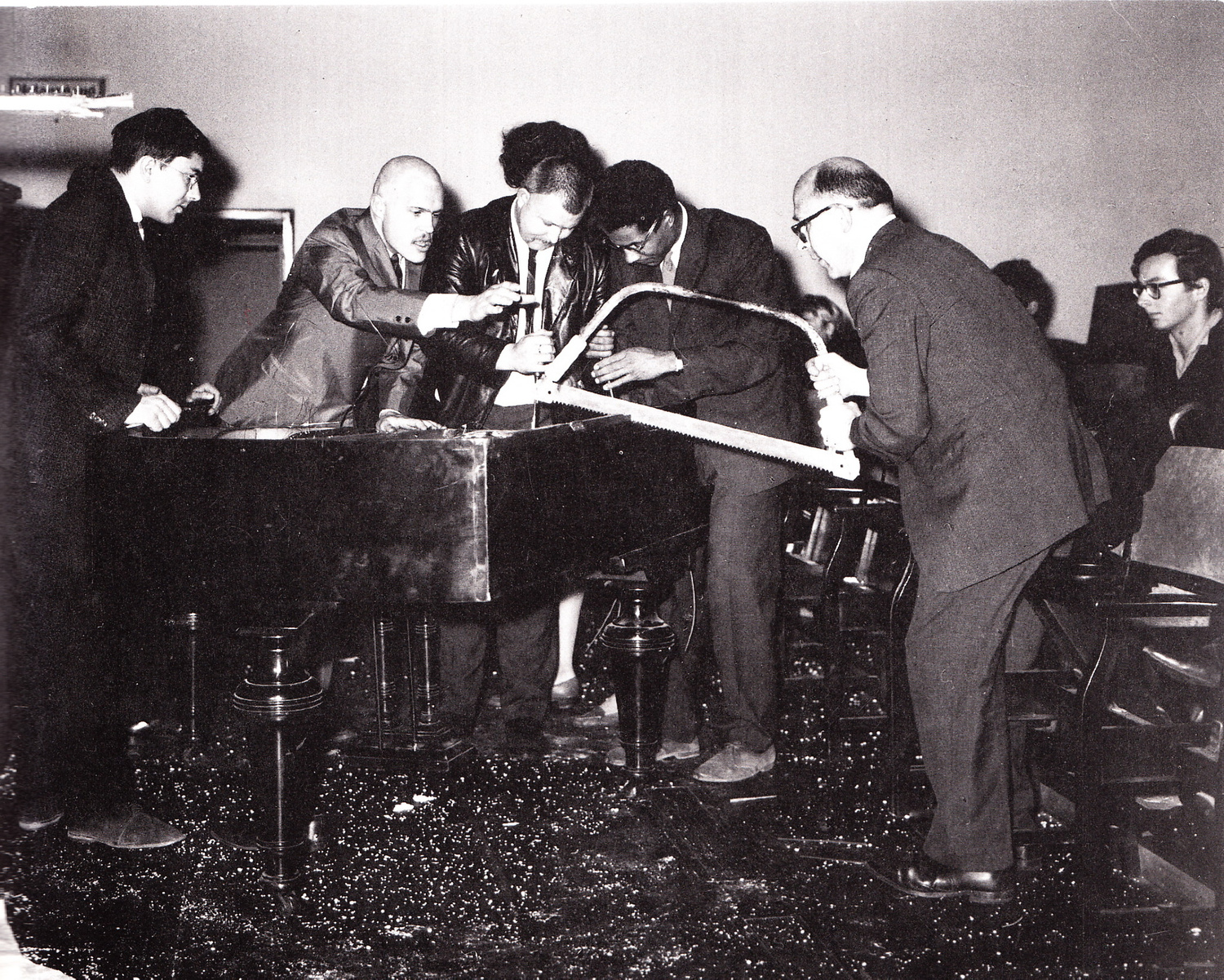
https://lcmf.co.uk/4-August-Keyboard-Breakdown-1
George Maciuna’s piano piece – much like his fellow Fluxus member Yoko Ono’s voice piece covered by Sonic Youth – is a performance taking music and performance to the limits. It is a part of his “Piano Activities” first performed in the first Fluxus festival in 1962, in Wiesbaden, Germany. The various “activities” included scratching, rubing, striking a piano in numerous ways.
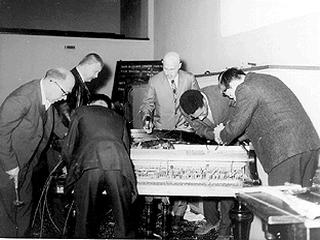
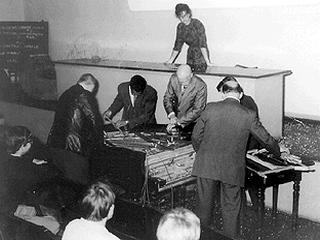
http://www.medienkunstnetz.de/works/piano-activities/images/1/
«Piano Activities»
Phil Corner's 'Piano Activities' was one of the pieces that raised the most scandal during the first, four-weekend-long series of Fluxus concerts in Europe. In a very free interpretation of Corner's score, George Maciunas, Dick Higgins, Ben Patterson, Alison Knowles, Wolf Vostell and Emmett Williams proceeded over the course of several days to take to pieces a grand piano, after which they auctioned the parts to the audience. Not all the pieces performed during the festival were so spectacular, however. The series of concerts included works by Fluxus members as well as international composers (John Cage, Pierre Schaeffer, Karlheinz Stockhausen, Richard Maxfield, Dieter Schnebel, Toshi Ichiyanagi, La Monte Young, George Brecht, and others). Pure tape compositions and films were on the programme, too.
https://fluxuslaphil.tumblr.com/post/179756603809/fluxus-historical-origins-and-contemporary
Fluxus: Historical Origins and Contemporary Resonances
by Natilee Harren
https://www.youtube.com/watch?v=KNLieHX7hfk
https://www.cocofusco.com/the-incredible-disappearing-woman
https://www.cocofusco.com/a-room-of-one-own
https://duckduckgo.com/?q=sharon+hayes+I+am+a+man&atb=v286-1&iax=images&ia=images&iai=http%3A%2F%2Fi.huffpost.com%2Fgen%2F1442514%2Fthumbs%2Fo-HAYES-900.jpg%3F1
https://www.huffpost.com/entry/the-reckoning_n_4179300
http://shaze.info/work/in-the-near-future/
https://www.moma.org/calendar/exhibitions/1296
https://plazalondon.wordpress.com/2011/01/19/claes-oldenburgs-store-1961/
https://www.villagepreservation.org/2019/02/05/how-much-is-that-plaster-in-the-window-claes-oldenburgs-the-store/
https://www.bagtazocollection.com/blog/2017/10/9/installation-study-claes-oldenburgs-consumer-goods
https://www.moma.org/collection/works/61054
https://www.moma.org/collection/works/126279
http://www.ultimateakademie.de/fluxusvirus.php
https://www.shivadas.be/clients/quinsy-gario
https://www.instagram.com/ehsan_fardjadniya/
https://www.instagram.com/p/CCvstDKiTh8/
https://www.youtube.com/watch?v=YFAAaPyzX64
http://barbadgolshiri.com/
http://ehsancritique.com/about-ehsan-fardjadniya/
https://www.bon-gah.com/
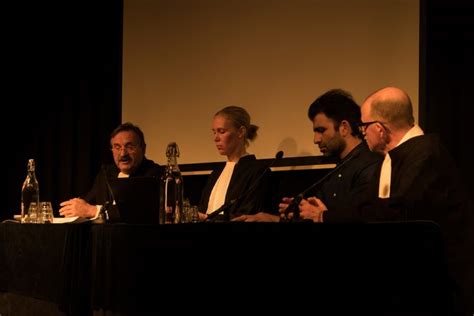

biography ehsan fardjadniya
Ehsan Fardjadniya portrait
Picture by Chun-Han Chiang (Dawson), ‘Round Heads and Pointed Heads, Scene II’ Performance at W139 part of ‘Ideology Meets Implementation’ exhibition November 2017.
Ehsan Fardjadniya’s biography:
Ehsan Fardjandiya (no age, no nationality) is a visual and performance artist. Most of his work are about re-defining the role of art as a catalyst of change through progressive subversion towards justice and emancipation from oppression. Fardjadniya’s works are conceptual performances and social sculptures that scrutinizes and intervenes the systems of power and normativity.
The rest of this biography prefers not to be framed as it should be
This biography prefers not to be about identity politics
This biography prefers not to be about “i” as the center of the world
“i” as the egoistic individual artist
This biography prefers not to be a list of institutions of power, exclusion, racism and colonialism
This biography prefers not to be a list of precarious works, unpaid labor and exploitation
This biography prefers not to be pretentions while hypocrite
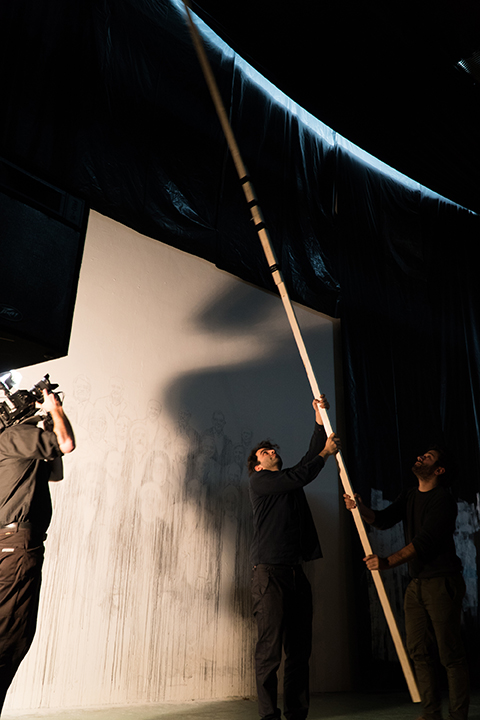
https://www.shivadas.be/
https://www.youtube.com/watch?v=YFAAaPyzX64
https://www.moma.org/collection/works/81074
https://www.tate.org.uk/art/artworks/kosuth-clock-one-and-five-english-latin-version-t01909
https://brooklynrail.org/2011/11/artseen/martha-wilson-and-the-well-examined-female-self
https://duckduckgo.com/?q=Camnitzer++Uruguayan+Torture+Series&atb=v292-1&iax=images&ia=images
https://www.thefreelibrary.com/Ilya+Kabakov%3A+%27Answers+of+an+Experimental+Group.%27-a016107183